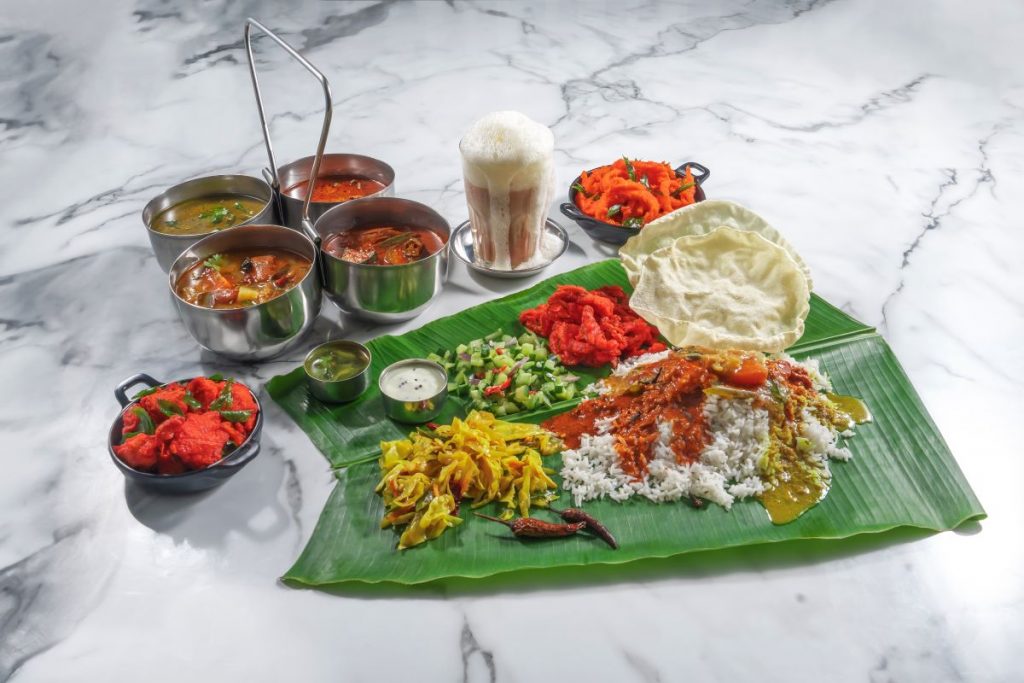Ever wonder what rice tastes like when cooked in banana leaf? In this article we are going to explain the taste of rice when cooked or wrapped in banana leaves. So, feed your curiosity and continue reading!
Introduction
The age-old practice of using banana leaves to serve white rice is deeply rooted in many cultures across Asia and other tropical regions. It reflects a tradition that spans generations and diverse communities. Banana leaves provide not only a sustainable and biodegradable alternative to disposable plates. On top of that, they also impart a unique flavor and aroma to the rice they serve.
People often use the large, flexible leaves to line serving trays or baskets. This provides a natural, aromatic bed for the fragrant rice to rest upon. The heat of the freshly cooked rice causes the leaves to release their natural oils and aroma. This infuses the rice with a subtle, earthy flavor that can elevate the dining experience.

In addition to the added flavor, using banana leaves in serving rice also holds cultural and symbolic significance in many communities. Using banana leaves is a way to honor the earth and its resources, and people often associate it with festive or celebratory occasions.
In order to truly appreciate the impact of banana leaves on the flavor of rice, a direct taste comparison between rice served with and without banana leaves is necessary. By experiencing both options side by side, it becomes clear just how much the banana leaves can enhance the overall dining experience.
The Distinctive Taste of Rice with Banana Leaf
In cooking, people commonly use banana leaves to impart a unique flavor and aroma to rice. When wrapping white rice in fresh leaves and then cooking it, the rice absorbs the natural oils, mineral content, and flavors present in the leaves, resulting in a subtly fragrant and flavorful dish.
The process of cooking white rice with banana leaves infuses the rice with a distinct, earthy aroma and a slight sweetness. The leaves also add a hint of grassy undertones to the rice, giving it a more complex flavor profile. The natural oils present in the leaves contribute to the rice’s texture, making it slightly more moist and tender compared to rice cooked without banana leaves.
The method of cooking rice with banana leaves is a traditional practice in many cultures, and it has stood the test of time for good reason. The leaves not only add a unique flavor to the rice, but they also impart a visual appeal, with their vibrant green color seeping into the rice during the cooking process.
Overall, cooking rice with banana leaves enhances the sensory experience of enjoying this staple food. The distinct aroma and subtle flavors that result from this method make it a delightful and special way to enjoy rice.
[Rice Cooked with Banana Leaf] Traditional Practices and Cultural Significance
In many Asian and tropical countries, serving banana leaf rice has deep cultural and traditional significance. The practice of serving food on banana leaves dates back to ancient times when it was readily available and served as an eco-friendly alternative to disposable plates.
In many cultures, banana trees are considered sacred and have religious significance, making the use of banana leaves a symbolic gesture of respect and gratitude towards nature. Additionally, the large size of banana leaves allows for the placement of various hot food and accompaniments, making it a practical and convenient serving option for communal meals.

The use of banana leaves in serving rice also adds a unique flavor and aroma to the dish, enhancing the dining experience. The natural oils present in the leaves infuse the rice with a subtle, earthy flavor, adding an authentic touch to the meal. Furthermore, the vibrant green color of the leaves adds visual appeal to the dining table, contributing to the overall aesthetic experience.
Overall, using banana leaves to serve rice not only reflects cultural and traditional values but also plays a significant role in enhancing the sensory and visual aspects of the dining experience, making it a cherished and integral part of many regional cuisines.
Rice without Banana Leaf: A Simpler Palette
The taste of rice when served without the aromatic touch of banana leaves is a simpler palate that allows the rice itself to take center stage. Without the added fragrance and subtle flavor imparted by banana leaves, the natural flavor of the rice becomes the main focus.
The simplicity of flavors is evident, allowing for a more direct expression of the rice itself. The absence of the aromatic touch of banana leaves brings out the pure, clean taste of the rice, highlighting its natural nuttiness and subtle sweetness. This allows for a more straightforward and unadorned experience, where the true essence of the rice can be fully appreciated.
Without the influence of banana leaves, the rice becomes a blank canvas, ready to be paired with various dishes and flavors. Its simplicity allows for versatility, as it can easily adapt to different culinary preparations and accompaniments. This simplicity also provides a more authentic and unadulterated experience, allowing the true qualities of the rice to shine through.
In conclusion, serving rice without the aromatic touch of banana leaves offers a simpler palate that celebrates the pure and direct expression of the rice itself. It allows for a more unembellished and genuine experience, where the natural flavors and qualities of the rice can be fully savored and enjoyed.
BananaBro’s Interpretation: Infusing Tradition with Innovation
BananaBro, a banana leaf rice restaurants, takes a traditional approach to serving white rice while also incorporating innovative culinary techniques to create unique and delicious dishes. When serving rice with banana leaves, BananaBro stays true to the traditional method of using these banana leaves as a plate, infusing it with a subtle, earthy aroma. This method not only preserves the authenticity of the dish but also adds a touch of nostalgia for those familiar with this classic presentation.

In addition to traditional offerings, BananaBro also showcases their creativity by serving rice together with flavorful curries such as chicken curry, mutton curry, fish curry, and dhal. We are using modern techniques and innovative flavor combinations to elevate the dining experience by hot-stamping our logo on the banana leaves. This balance of tradition and innovation allows BananaBro to offer a savoury rice dishes, appealing to both those seeking a taste of tradition and those looking for a more contemporary culinary experience.
BananaBro’s Special
Most of our frequent diners really enjoy their banana leaf rice meal while spending quality time with their families especially during special occasions like birthday celebrations or family dinner. Located in Kuala Lumpur, Klang Valley and all over Malaysia, BananaBro has more than 30 outlets serving the best banana leaf rice meal.
We acknowledge Malay cuisine heritage by offering complimentary side dishes that you comes together with the banana leaf rice meal in Craving Sets. Our variety of curries are freshly cook and served hot from the kitchen. We use a number of spices and herbs together with curry leaf to ensure the taste and thickness of our curries.

As a popular banana leaf rice restaurant, BananaBro’s approach to Malaysian dishes reflects their commitment to honoring tradition while embracing innovation. Whether it’s a nod to the past or a creation of the present, BananaBro’s rice offerings are a testament to their dedication to providing a unique and memorable dining experience.
Conclusion
After embarking on a journey of taste comparison, it is clear that the nuances in flavor and cultural practices play a significant role in shaping our culinary experiences. Whether it’s the traditional approach passed down through generations or a modern interpretation like BananaBro’s, there is so much to appreciate and savor.
From exploring the depth of flavors in traditional dishes to appreciating the creativity and innovation in modern culinary creations, this taste comparison journey has been an eye-opening experience. It is a reminder that there is no one-size-fits-all when it comes to taste, and each culture brings its own unique flavors and techniques to the table.
As we conclude this journey, we invite you to continue exploring the world of flavors and to savor both the traditional and the modern interpretations. Let’s appreciate the diversity in taste and cultural practices, and open our palates to new experiences. Whether it’s a classic dish prepared with time-honored traditions or a modern twist on a familiar favorite, every flavor has a story to tell.
Let’s celebrate the richness of cultural diversity through the appreciation of food, and continue to explore the endless possibilities of taste. Cheers to the flavors that unite us and the nuances that make each culinary experience truly special.
Head on to the nearest BananaBro outlet to enjoy a meal of banana leaf rice. Skip the queue and click here to reserve a table today! Don’t forget to follow our social media so you don’t miss the best promotion, served hot and fresh from BananaBro’s kitchen. We are on Facebook, Tiktok, Youtube and Instagram.

![[Taste Test] Rice with and without Banana Leaf](https://www.bananabro.com.my/wp-content/uploads/2024/01/1-19.png)